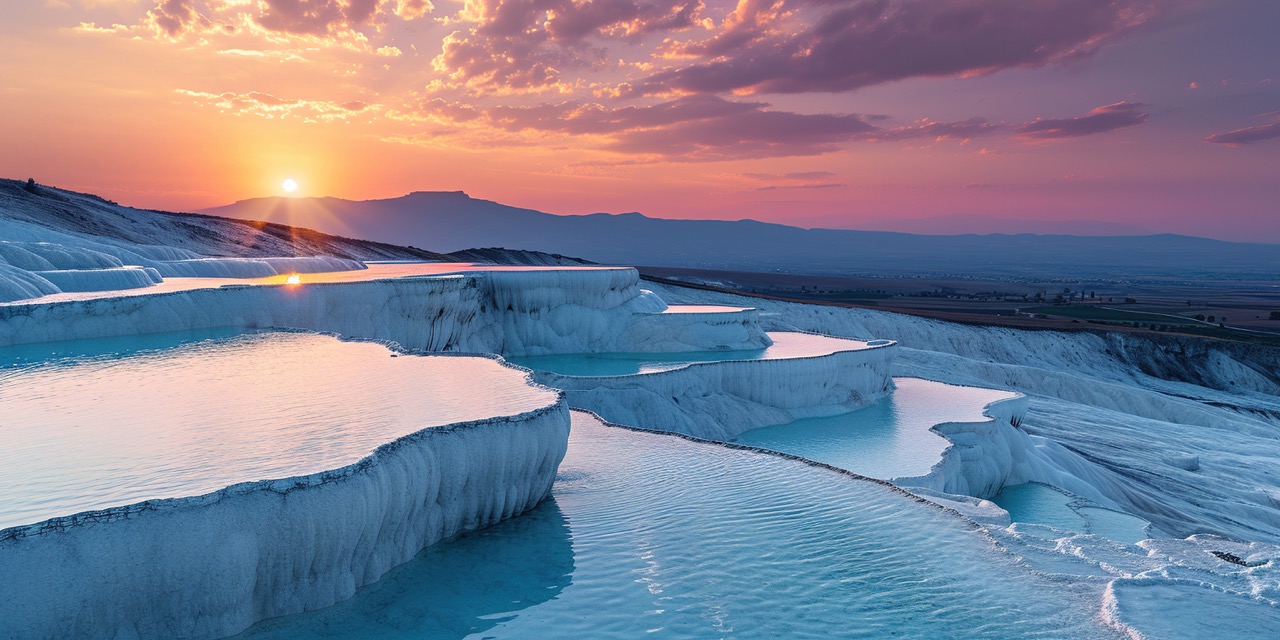Pamukkale, located in southwestern Turkey, is a destination like no other. Known for its surreal white travertine terraces, healing thermal waters, and ancient ruins, Pamukkale has earned its place as one of Turkey’s most famous natural and historical sites. This detailed guide will explore what makes Pamukkale so special and why it’s a must-visit destination for travelers.
1. The Travertine Terraces: Pamukkale’s Iconic Cotton Castle
Pamukkale is most famous for its stunning travertine terraces, a natural wonder often referred to as the "Cotton Castle" (the literal translation of "Pamukkale" in Turkish). These terraces were formed over millennia by calcium-rich thermal springs flowing down the hillside, creating shimmering white pools of mineral water.
- Why It’s Famous: The unique white terraces, which resemble cascading cotton or snow, are one of the most recognizable landmarks in Turkey. The natural beauty of these formations makes them a popular spot for photography and relaxation.
- Pro Tip: While some areas of the terraces are protected, visitors are allowed to wade through designated sections, making it a truly immersive experience.
2. Hierapolis Ancient City: A UNESCO World Heritage Site
Above the travertine terraces lies the ancient city of Hierapolis, a UNESCO World Heritage site that was once a major Roman spa city. Founded in the 2nd century BC, Hierapolis thrived as a place for healing and relaxation, thanks to its abundant thermal waters. The city is filled with well-preserved ruins that showcase its historical and cultural significance.
2.1. The Roman Theatre
One of the standout attractions in Hierapolis is the Roman Theatre, a massive structure that once held up to 15,000 spectators. Built during the reign of Emperor Hadrian, the theatre is remarkably well-preserved and offers stunning views of the surrounding landscape.
- Why It’s Famous: The theatre is one of the best-preserved in Turkey, showcasing the grandeur of Roman architecture and providing a window into the cultural life of the ancient city.
2.2. The Necropolis
Another significant site in Hierapolis is the Necropolis, one of the largest ancient cemeteries in Turkey. Stretching over 2 km, the necropolis contains thousands of tombs and sarcophagi, offering a fascinating glimpse into the burial practices of the time.
- Why It’s Famous: The sheer size of the necropolis and the variety of tomb styles make it an impressive and historically rich site.
3. Cleopatra’s Pool: Swim Among Ancient Ruins
Also known as the Antique Pool, Cleopatra’s Pool is another famous attraction in Pamukkale. According to legend, the pool was a gift from Mark Antony to Cleopatra. Today, visitors can swim in this thermal pool surrounded by submerged marble columns and ruins from the ancient Roman era.
- Why It’s Famous: The unique experience of swimming in a pool filled with ancient Roman ruins, along with the warm, mineral-rich waters, makes Cleopatra’s Pool one of the most popular spots in Pamukkale.
- Pro Tip: There is an additional fee to swim in Cleopatra’s Pool, but it’s well worth it for the relaxing experience.
4. The Healing Thermal Waters: Pamukkale’s Natural Spas
Pamukkale has been famous for its thermal waters for thousands of years. The mineral-rich hot springs that flow through the travertine terraces and feed Cleopatra’s Pool have long been believed to have healing properties. Visitors flock to Pamukkale to experience the health benefits of these waters, which are said to help with ailments such as skin conditions, arthritis, and circulatory issues.
- Why It’s Famous: Pamukkale’s thermal waters have been a draw for health and wellness seekers since ancient times. The combination of relaxation, natural beauty, and healing makes it a unique wellness destination.
- Pro Tip: Be sure to take advantage of the designated areas where visitors are allowed to dip their feet into the warm, soothing waters of the terraces.
5. The Red Springs of Karahayit: A Unique Thermal Experience
Just a few kilometers from Pamukkale is the village of Karahayit, known for its red thermal springs. The mineral content of these springs creates striking red and brown deposits, offering a unique contrast to the white travertine terraces of Pamukkale. The springs here are also believed to have healing properties, making Karahayit a popular spot for thermal spa enthusiasts.
- Why It’s Famous: While Pamukkale’s terraces are white, Karahayit’s red springs offer a different and equally fascinating thermal experience.
- Pro Tip: If you have time, consider visiting Karahayit for a more off-the-beaten-path experience and to enjoy its peaceful thermal pools.
6. UNESCO World Heritage Status: Preserving Pamukkale’s Natural and Historical Significance
Pamukkale, along with the ancient city of Hierapolis, was designated a UNESCO World Heritage Site in 1988. This status recognizes Pamukkale’s unique combination of natural beauty and historical significance. The efforts to preserve the site have helped maintain the integrity of both the travertine terraces and the ancient ruins, allowing visitors to experience Pamukkale much as it has existed for centuries.
- Why It’s Famous: Pamukkale’s inclusion on the UNESCO World Heritage list underscores its global importance as both a natural wonder and a historical treasure.
FAQs for Irish and UK Travelers
- Why is Pamukkale famous?
Pamukkale is famous for its travertine terraces, thermal springs, and the ancient city of Hierapolis, a UNESCO World Heritage site. The combination of natural beauty and historical significance makes it a must-visit destination in Turkey. - What makes Pamukkale unique?
Pamukkale’s unique white terraces, formed by mineral-rich hot springs, create a stunning and otherworldly landscape. The region’s thermal waters have been used for healing since ancient times, and the ancient ruins of Hierapolis add a historical dimension to the experience. - Can you swim in Pamukkale’s hot springs?
Yes, you can swim in designated sections of the travertine terraces and in Cleopatra’s Pool, a thermal pool filled with ancient Roman ruins. - What are the historical sites in Pamukkale?
The main historical sites include the ancient city of Hierapolis, the Roman Theatre, the Necropolis, and Cleopatra’s Pool. - What are the travertine terraces in Pamukkale?
The travertine terraces are natural formations created by mineral-rich thermal waters flowing down the hillsides. Over time, these minerals have built up to form the stunning white terraces that Pamukkale is famous for.
Conclusion: What Makes Pamukkale So Famous?
Pamukkale’s fame comes from its remarkable combination of natural beauty, healing thermal waters, and ancient history. From the iconic white travertine terraces to the rich cultural heritage of Hierapolis and Cleopatra’s Pool, Pamukkale offers visitors a unique experience that blends wellness, nature, and history. Whether you’re drawn to its relaxing thermal springs or its fascinating ancient ruins, Pamukkale is a destination that leaves a lasting impression on all who visit.
 English
English














